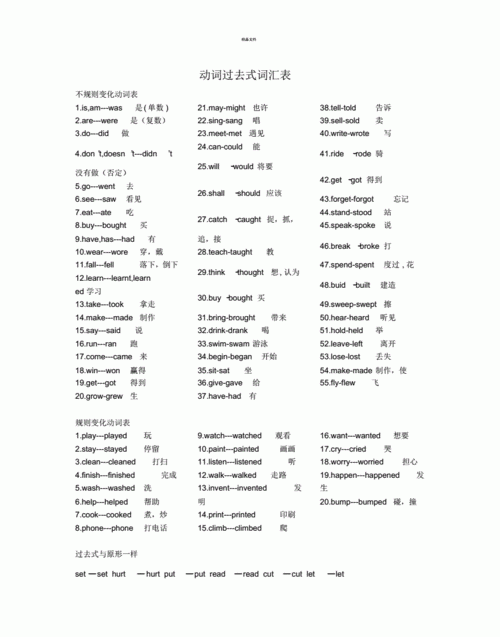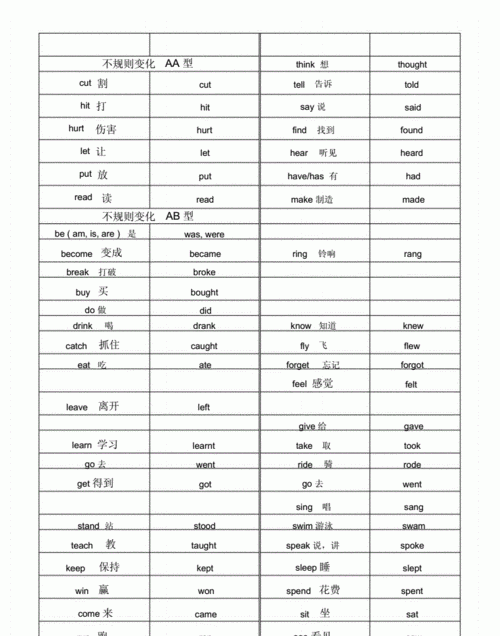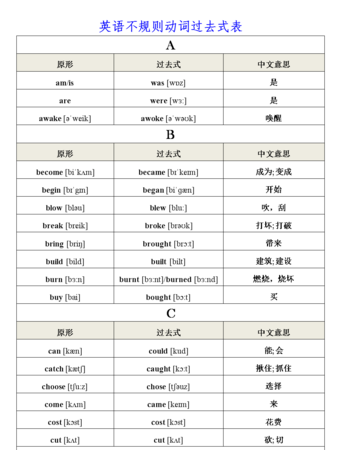本文目录
三到六年级动词过去式和原形
read the letters读信 buy a cake for him为他买个蛋糕 be fine很好 go to school去上学 say hello to sb向某人问好 say goodbye to sb向某人再见 visit my school参观我的学校 look at a photo看图片 welcome to our school欢迎来到我们学校 behind the lake在湖后面 feed the birds 喂鸟 make a note 写笔记 in the zoo在动物园 play football踢足球 between the lakes在湖中间 have an ice cream吃冰淇淋 close the gate 关门 near the left of my house在我房子的左边 on the left of the park在公园的右边 in the middle of trhe playground在操场的中间 play a game玩游戏 on their left在他们左边 pick the flowers摘花 in Tom's school在汤母的学校 at the back of在~~的后面 wake up叫醒 look at the time看时间 want to go to sleep想去睡觉
have to必须 go there去那 open the door开门 close the window关窗 by bike骑车 by bus坐汽车 come from来自 at the shop在商店 play with friends和朋友玩 under the bed在床下 make a card做张卡片 go to my home去我家 watch the moon赏月 have a look看看 have a party举行聚会 buy a cake买蛋糕 buy them买他们 near the school在学校附近 go fishing去钓鱼 go running去跑步 in the morning在早晨 in the afternoon在下午 at night在晚上 in the evening在夜晚 have a car 有一辆汽车 eat dumplings吃饺子 eat the cake吃蛋糕 have a dinner举行晚宴

小学六年级的动词过去式不规则的都有哪些
1、中间去e末尾加t,如:
keep→kept,feel→felt,sleep→slept,sweep→swept
2、结尾d变t,如:
build→built,lend→lent,send→sent,spend→spent
3、遇见i改为a,如:
ring→rang,sit→sat,drink→drank,sing→sang,swim→swam,begin→began,give→gave
4、“骑(马)”“开(车)”“写(字)”——把i变o
如:ride→rode,drive→drove,write→wrote
5、“想”“买”“带来”“打仗”——ought换上,如:think→thought,buy→bought,bring→brought,fight→fought
6、“教书”“抓住”——aught切莫忘,如:
teach→taught,carry→caught
7、ow/aw改为ew是新时尚,如:
know→knew,grow→grew,throw→threw,draw→drew
8、“放”“让”“读”过去式与原形一个样,如:put→put,let→let,read→read/red/

六年级上册英语动词有哪些
一至六年级的英语动词有be动词、情态动词、助动词、行为动词。
一、be动词(am,is,are,was,were )
1、amwas,is was,are--were口诀:我用am,你用are,is用在他她它,所有复数全用are。
2、肯定和否定句I am (not) from London. He is(not) a teacher. She is(not) in the dining room. My hair is(not) long. Her eyes are(not) small.
3、一般疑问句Am I a Chinese? Yes,you are. No,you arent. Are they American? Yes,they are. No,they arent. Is the cat fat? Yes,it is. No,it isnt.
4、be动词的否定形式:am not(没有缩写形式),are not = arent,is not = isnt.

二、助动词(do,does,did )
do,does用于一般现在时,其过去式did用于一般过去时。它们通常用在疑问句和否定句中。它们的否定形式:do not = dont,does not = doesnt,did not = didnt.
注意:在一般现在时中,does用于第三人称单数,其余一律用助动词do;助动词do,does,did后面一定要用动词原形。
三、情态动词
情态动词也是一类特殊的动词,平时我们不把它说成是动词。情态动词可以和行为动词同时出现在同一个句子中。我们现在学过的情态动词有:can、could、shall、should、will、would、may、might、must.注意:情态动词后动词总是用原形。(不受其他任何条件影响)
四、行为动词
就是平时上课时说的动词,表示某一动作或行为。如:sweep、live等。行为动词我们已学过它们的四种形式:原形、第三人称单数+s/es、现在分词(也叫动名词)+ing、过去式+ed。
动词第三人称单数变化规则:
A、一般直接加s,如:play plays,visit visits,speak speaks.
B、以s,x,sh,ch结尾时,加es,如:catch catches,watch watches.
C、以辅音字母+y结尾时,变y为i再加es,如:carry carries,study studies.
发音英语动词和名词
PEP六年级下册四会单词词汇表
Unit 1
tall—taller更高的 short—shorter 更矮的 strong—stronger 更强壮的 old—older 年龄更大的 young—younger 更年轻的 big—bigger 更大的heavy—heavier 更重的 long—longer 更长的 thin—thinner 更瘦的 small—smaller (体型)更小的
答案补充 太多了,打不完

以上就是关于到6年级所有动词 ,三到六年级动词过去式和原形的全部内容,以及1到6年级所有动词 的相关内容,希望能够帮到您。

